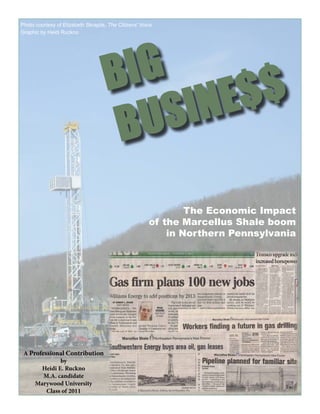
Pc Updated
- 1. Photo courtesy of Elizabeth Skrapits, The Citizens’ Voice Graphic by Heidi Ruckno B IG SI NE $$ BU The Economic Impact of the Marcellus Shale boom in Northern Pennsylvania A Professional Contribution by Heidi E. Ruckno M.A. candidate Marywood University Class of 2011
- 2. About the Marcellus Shale RegioN The Marcellus Shale region is the largest nat- ural gas play in the United States, spanning 95,000 square miles in Pennsylvania, New York and West Virginia, along with parts of Maryland, Ohio and Virginia. Conversely, the Barnett natural gas field in Texas, cur- rently the most productive American natu- ral gas field, spans 5,000 square miles. It is estimated that the Marcellus Shale re- gion has 489 trillion cubic feet of recover- able natural gas, and only a fraction of that, or 14 trillion cubic feet, will be recovered by 2015. This abundance could make the re- gion a major energy player for generations to come. Bradford County in the Northern Tier of Pennsylvania is in the heart of the Marcellus Photos by Heidi Ruckno Shale boom, along with the nearby counties of Susquehanna and Tioga. During the sec- Potential Economic Impact ond half of 2010, those three counties pro- duced a third of the state’s natural gas. The extraction of natural gas from underneath the Marcel- lus Shale involves a process called hydraulic fracturing, more commonly known as “fracking.” During fracking, millions of gallons of chemically treated water are blasted thousands of feet underground. The pressure cracks the shale, releasing the natural gas. The Marcellus Shale Coalition, a lobbying group for the drill- ing industry, said the industry has directly or indirectly created more than 88,000 jobs. It takes about 410 individuals, working at 150 occupations in order to drill one well, and an average of 20 to 30 contract companies will be utilized in the process. Source: Northeast Driller
- 3. Growing Industries Column graphics by Heidi Ruckno Source: Bureau of Labor Statistics Many industries are currently seeing growth that could be directly attributed to the Natural Gas industry. The Mining and Logging industry has added nearly 4,000 jobs in the last six months alone. Construction is also trending upward, as is job growth in the Trade, Transportation and Utilities sectors. Also seeing significant gains is the Education sector, as more institutions scramble to offer gas-friendly curricula.
- 4. Photo courtesy of Elizabeth Skrapits, The Citizens’ Voice Environmental Concerns vs. Economic Benefit The natural gas industry has been heavily criticized by environmental advocates who believe the fracking process contaminates the drinking water supply. In 2009, the Pennsylvania Department of Environmental Protection cited Cabot Oil and Gas for violating a variety of environmental regula- tions, resulting in a settlement that left Cabot on the hook for more than $120,000 in fines. Fifteen residents of Dimock Township, Susquehanna County, subsequently sued Cabot in Federal court. The high-profile case prompted many Northeastern Pennsylvania lawmakers, including State Rep. Phyllis Mundy, D-Kingston, to advocate for a moratorium on gas drilling while state regulators scramble to catch up to the ever-increasing need for their services. DEP has diligently expanded its regulatory force over the last few years, but the agency has trouble recruiting and retaining quali- fied employees. Many of them are lured away from the public sector by more lucrative opportuni- ties with private sector energy companies. The concerns of opponents are valid, if not warranted, but the economic benefit far outweighs any environmental risks. Energy companies are investing billions into the region, hiring people and opening corporate offices. Rural Northern Tier counties used to have unemployment rates far higher than the state average, but now they enjoy some of the lowest unemployment rates in the state. Mining, construction and transportation jobs are being created, and the region’s educational instutions are adapting their curricula to meet the employment needs of the energy companies.